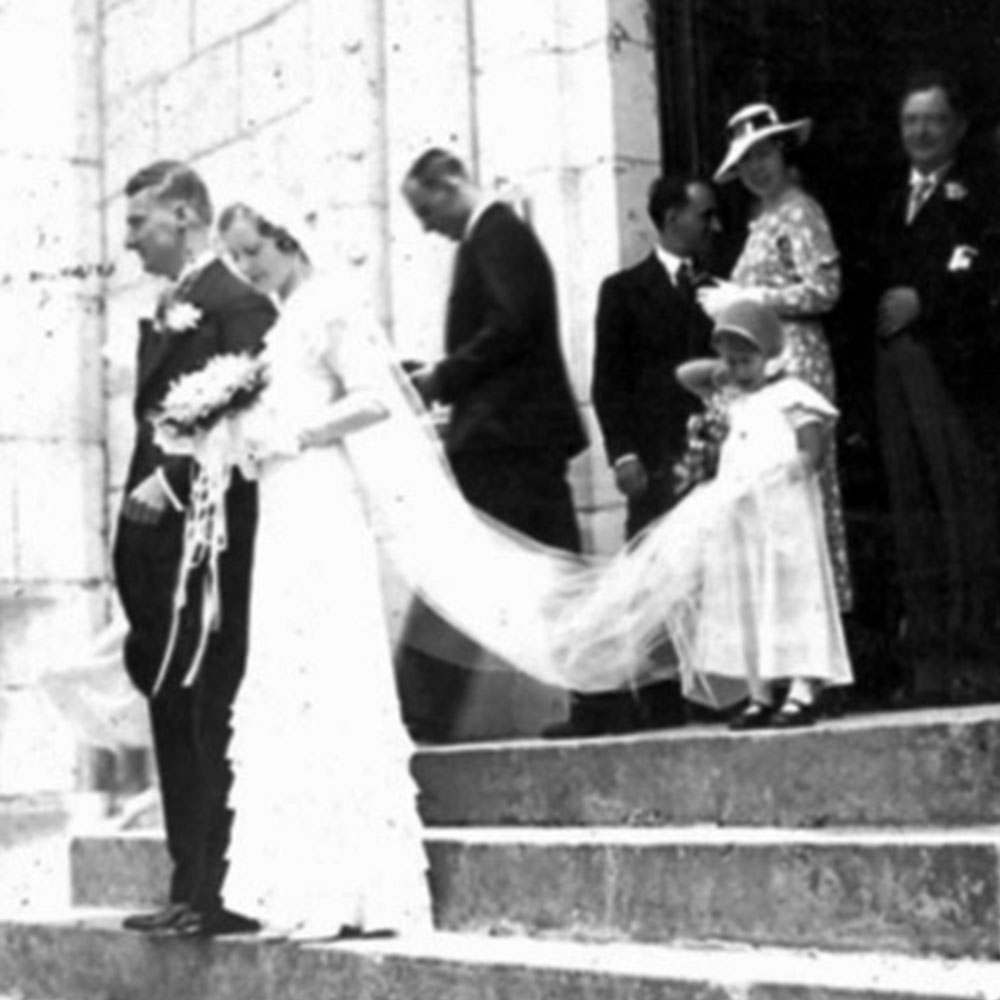Jean Paul de la Chapelle
In June 2023, I had a chance to talk with Jean Paul de la Chapelle (JPD) who was at his home in Neuville sur Saône, a suburb just outside Lyon, France. Our goal was to record some of the history of his extended family. Our hope is that in later years it may be of interest to family members curious about the relationships between the various de la Chapelles and descendants of the Gwinn, Riboud, Lacombe, Kuhn, Corderoc’h, Bowe, and Casey families.
The interview is available in both English and French. Simply choose one of the closed captions available at the CC icon of the toolbar under the video. If you click on the grid icon to the right of the CC icon, up will pop up the a list of the interview’s chapters. Clicking on these chapter headings permits you to jump around the interview at will to parts you find of interest. You’ll find further details on the subjects covered by Jean Paul in these chapters below.
Chapter 1. After a brief review of all the topics we hope to cover in our talk, JPD discusses how his parents, Peter de la Chapelle and Chesley Riboud met in Chicago. He says his father had an “open and unconcerned” attitude about his later career following his graduation from Princeton University, and spent some time after his graduation following his interest in the theater. He explains that Peter’s father, Richard de la Chapelle, continued in this period to encourage Peter to follow in his footsteps and pursue a career in banking or finance. After Peter and Chesley’s marriage in 1961, I recall their coming from their home in Bronxville, New York to my 1964 graduation from Yale University.
Chapter 2. I recall the engagement party for Peter and Chesley in New York City held in the Manhattan apartment of Peter’s parents, Richard and Frances Malone de la Chapelle. This apartment on 5th Avenue near the Metropolitan Museum of Art was in addition to their house in Tenafly, New Jersey JPD mentions that Peter de la Chapelle’s eldest brother Richard had been unable to discover much information about his mother’s family. JPD says Francis Malone de la Chapelle was known for her “fun Irish attitude,” and “surprising way of thinking,” but little is known of her Irish family’s origins. He says she was one of 13 children and the family may have emigrated from Counties Galway, Kilkenny or Clare, Ireland, and in any event, ended up settling in Louisville, Kentucky.
Chapter 3. JPD discusses the rich history of the Passarat branch of his family, including the prominence of Passarat ancestors in France in the 16th Century and later. He notes their service to the Kings in battle and the land grants given to them in the Lyon area as a result.
Chapter 4. JPD talks about his father Peter’s early financial career in New York, and his bold and risky move to France, where he quickly found his footing in a financial market that had just begun to develop.
Chapter 5. JPD reviews the birth of his siblings, first David in New York, and then Timothy in France. He says the move to France gave his father Peter the next chapter in his banking career. JPD also discusses the difficulties he himself had as a young boy adjusting to the move, having spoken only English as he grew up in Bronxville.
Chapter 6. The early life of his mother Chesley is sketched by JPD. Born in 1934, the same year as his father Peter, he says she fled France to spend the years of World War II in the Gwinn family home in Baltimore, Maryland with her sisters Betsy and Olivia (Livie), and her mother Nancy Gwinn Riboud. He describes her return to France at the age of 13 in 1947 and schooling near the family apartment on Avenue Georges Mandell in Paris. He goes on to talk about her own difficulties in this period and her later studies back in the United States at Trinity College and elsewhere.
Chapter 7. JPD recounts Nancy Gwinn Riboud’s flight from the Nazi army from Chindrieux with his mother Chesley, and her sisters Betsy and Olivia first to Portugal and then to Baltimore, where they spent the war years. He says his mother had had nutrition related health issues since birth which complicated her life during this ordeal, and noted the family was sheltered in this period in the Gwinn family home in Mt. Washington. The home at the time was presided over by Nancy Gwinn Riboud’s mother, then widowed Elizabeth Tack Gwinn. JPD closes by noting the nature of life in Chindrieux during the war, and the frequent presence of members of the Resistance.
Chapter 8. JPD discusses the birth of his two brothers, David in 1968 in the U.S., and Timothy, after the family’s move to France. He goes on to discuss David’s schooling, later interests in photography, and later life in Spain as well as in France.
Chapter 9. Timothy de la Chapelle’s musical skills are reviewed, as well as the Gwinn family musical heritage passed down by his mother, Chesley. He goes on to discuss Timothy’s marriage to Ai Shi and their three children, Eva, Arthur, and Victoria.
Chapter 10 JPD recalls the short life of his older sister, Anne Teresa, who is buried in the family plot in Chindrieux, France.
Chapter 11. After his schooling and an unexpected Army tour at Les Invalides, JPD tells of unexpectedly losing a wager on being offered a job in France. In consequence, he heading off the the U.S. to pursue a different path of employment. He says that while staying in Rhode Island with Peter Fagan, a Malone

1990 Jean Paul de la Chapelle, Sophia Lacombe, Margaret Casey & Bill, Cathy, Andy & Pat Bowe
family member, he first took a job with the Narragansett clothing chain for several months before being an Army comrade put onto a job in Boston in the Prudential Building with the telecommunications company MCI. He explains that while there he is alerted to another job, this time with a French company, Bologna Marble, headquartered in San Francisco.
Chapter 12. While preparing to take the job in San Francisco, JPD learns from his mother that his brother David has been in a life threatening industrial accident and JDP decides to return to France. JPD accepts an offer to work with his grandfather Jacques Riboud in Paris at the Centre Jouffroy, but before heading back to Paris, he takes time out with his cousin Sophia Lacombe to visit other family in U.S. That included a visit to me in Northbrook, Illinois, as shown in this picture of Jean Paul, Sophia with me, Cathy, Andy and Pat Bowe and Margaret Casey.
Chapter 13. JPD describes his work with Jacques Riboud at Centre Jouffroy, Jacques’s pursuit of developing a European Currency Unit (ECU), and his publications on monetary theory. I recall my arranging a meeting between Jacques and Arthur Burns, then Chairman of the U.S. Federal Reserve Bank. JPD closes by noting Jacques Riboud’s purchase of the Revue Politique et Parliamentaire.
Chapter 14. JPD says that after four years he left his work at Centre Jouffroy for four years to work as an export manager for the U.S.-based Prince Castle company for three years. He notes that Prince Castle was headquartered in Carol Stream, Illinois not far from where I live. Among other things, the company is famous for a famous milk shake machine once sold by its salesman Ray Kroc. Kroc went on to found the MacDonalds restaurant chain. JPD notes the job involved frequent travel rom his home in Troyes, France, through Paris to the U.S.
Chapter 15. JPD says that a later business downturn during the “Mad Cow” time sent him into a period of freelance work, including starting a video communications company. With other jobs, including working for a Swedish company, JPD describes shuttling between Chindrieux and Paris. He says and his brother had the benefit then of a flat in a building Jacques Riboud had built in the Belleville area of northeast Paris. JPD reports that his Army comrade introduced him to his sister Laetitia in 1997. He continued working in different export fields, including in 1999 in debt recovery for Chambery-based FDI, part of the Geodis firm. He was then still living in Chindrieux. He later moved with Laetitia to Antony, a suburb south of Paris at a time when his mother’s cancer finally took her life. JPD and Laetitia married in 2000, in the southwest of France in Charente, the home of Laetitia’s family. After Laetitia found a position working for a senior project manager of Peugeot, they moved to Pontchartrain, a Jacques Riboud development in a suburb to the west of Paris, and there started their family. Soon the family grew with the births first of Chloe in 2001, then Xavier in 2003, Helene in 2005, and Vincianne in 2006. In these years, JPD says he began working as a trainer and teaching business English, while Laetitia continued working for Peugeot.
Chapter 16. JPD says that his father began spending more time in the U.S. visiting with his several of his siblings following Chesley’s death. JPD and Laetitia and the family moved into the de la Chapelle family home in Chindrieux and Jean Paul began working remotely from there. He says that he was pleased he was able to reconnect with Betsy Riboud Lacombe at this time, as she had moved into the nearby Riboud home in Chindrieux.
Chapter 17. JPD explains that he was forced to shift his job orientation while he was in Chindrieux, and that it was difficult and time consuming to push himself towards adult education and teaching at the college and university level. In this period, he notes his father died. JPD says a combination of these factors led the family move to Neuville sur Saône, near Lyon. Roughly coincident with these events, and with Timothy’s return from Japan, the de la Chapelle family home in Chindrieux was sold in 2011.
Chapter 18. In 2007-2008, JPD says the family spent four to five months in the U.S. in order to obtain U.S. passports for their children. Part of this time he says was spent in Breckinridge, Colorado, where Charley Bowe was a sometime skiing visitor. In spite of the hassle, JPD says the result was that all of the children got their U.S. passports.
Chapter 19. JPD recounts his recent years teaching finance at technical universities in Lyon and his current business venture of supplying age appropriate equipment to the senior market in the Lyon region.
Chapter 20. JPD and I conclude our conversation with JPD discussing the de la Chapelle relationships over the years with their Riboud and Lacombe relatives, and he and I talk about next steps in adding more photos and family stories to the www.wbowe.com website.









